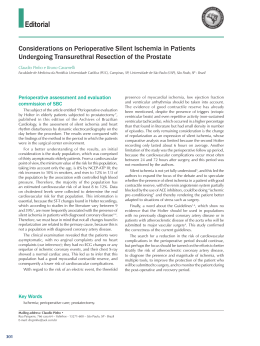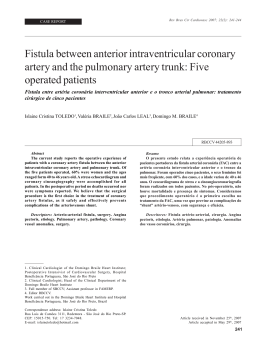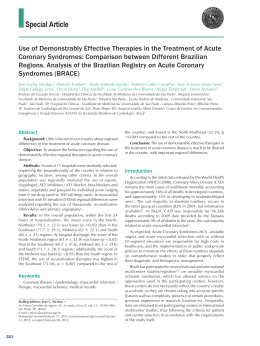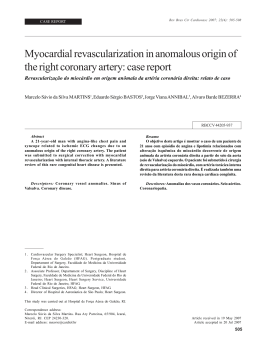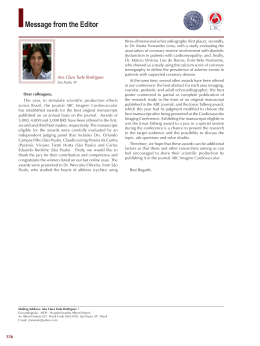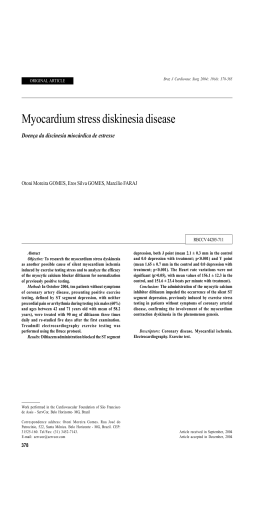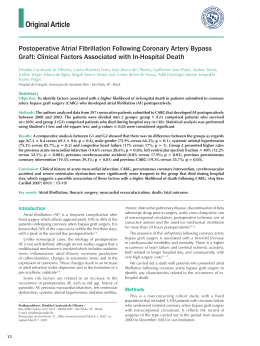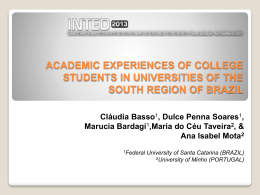Letter to the Editor Association is Not the Same as Accuracy Luis Cláudio Lemos Correia and Carolina Esteves Barbosa Escola Bahiana de Medicina e Saúde Pública, Salvador, BA - Brazil Dear Editor, In a recent article, dos Santos et al. have concluded that, for patients with acute coronary syndromes, risk scores correlated with coronary artery disease severity1. That apparently positive conclusion hides the poor performance of those scores to predict obstructive coronary artery disease due to two reasons. Firstly, in face of a diagnostic situation (presence of coronary artery disease ≥ 50%), the clinical focus should be on accuracy. Secondly, association (described in the article as correlation) does not ensure accuracy. The major focus of that study should have been accuracy measures, such as area under the ROC curve, ranging from 0.56 to 0.70. Although statistically significant, those values indicate low accuracy from the diagnostic viewpoint. Corroborating those findings, in a recently published article in this same journal, our group has concluded that the degree of association (between scores and coronary anatomy) is not sufficient for risk scores to accurately predict the results of angiography2. The different conclusions from two studies of similar findings is due to the perception that statistical significance (true association) and clinical relevance (accuracy) do not exactly represent the same phenomenon. Keywords Accuracy; Grace score; TIMI score; Coronary anatomy. Mailing Address: Luis Cláudio Lemos Correia • Av. Princesa Leopoldina, 19/402, Graça. Postal Code 40150-080, Salvador, BA - Brazil E-mail: [email protected], [email protected] Manuscript received July 30, 2013; revised manuscript September 03, 2013; accepted September 04, 2013. DOI: 10.5935/abc.20130251 References 1. dos Santos ES, Aguiar Filho Lde F, Fonseca DM, Londero HJ, Xavier RM, Pereira MP, et al. Correlation of risk scores with coronary anatomy in non-STelevation acute coronary syndrome. Arq Bras Cardiol. 2013;100(6):511-7. 2. Barbosa CE, Viana M, Brito M, Sabino M, Garcia G, Maraux M, et al. Accuracy of the GRACE and TIMI scores in predicting the angiographic severity of acute coronary syndrome. Arq Bras Cardiol. 2012;99(3):818-24. Reply When Santos et al1 have concluded that risk scores correlate with coronary anatomy, they considered all analyses performed: statistical correlation analysis with the non‑parametric Spearman test2 and the predictive ability of those scores to discriminate individuals who might and might not have a coronary artery lesion ≥ 50%, which was initially determined by using the non-parametric Mann-Whitney test2, and was later assessed by using C statistics (area under the ROC curve)3. As shown in the results, that study emphasizes both analyses: assessment of the existence of a relationship between risk scores and coronary anatomy (Table 3) and the predictive ability of the scores to discriminate who might have coronary lesion ≥ 50% (Chart 1). Thus, the word “correlation” cited in the 105 manuscript1 was used as the “relationship between risk scores and coronary anatomy”. The TIMI 4 and GRACE 5,6 risk scores have not been primarily developed to predict coronary lesion, but adverse clinical events. Thus, they are not supposed to have a strong discriminatory power to assess coronary lesion ≥ 50% or any other variable different from the specific clinical events of the original model. Nevertheless, they showed an ability that cannot be overlooked7 to discriminate who will or will not have coronary lesion ≥ 50% as follows: TIMI risk score, area under the ROC curve = 0.704; hospital GRACE score, area under the ROC curve = 0.623; 6-month GRACE score, area under the ROC curve = 0.562. Correia et al. Association versus accuracy Letter to the Editor It is worth noting that, for the TIMI risk score, the area under the ROC curve in the study by Santos et als.1 was greater than that for the specific events of the original model of development (area under the ROC curve = 0.65) 4. Similarly, the TIMI risk score, despite its limited predictive ability7 for adverse clinical events, due to its clinical relevance and practicality, is one of the most used models worldwide, recommended by national and international guidelines. Sincerely, Elizabete Silva dos Santos Luciano de Figueiredo Aguiar Filho Luiz Minuzzo Roberta de Souza Ari Timerman References 1. dos Santos ES, Aguiar Filho Lde F, Fonseca DM Fonseca, Londero HJ, Xavier RM, et al. Correlação dos escores de risco com a anatomia coronária na síndrome coronária aguda sem supra de ST. Arq Bras Cardiol. 2013;100(6):511-7. 5. 2. 6. Eagle KA, Lim MJ, Dabbous OH, Pieper KS, Goldberg RJ, Van de Werf F, et al; GRACE Investigators. A validated prediction model for all forms of acute coronary syndrome: estimating the risk of 6-month postdischarge death in an international registry. JAMA. 2004;291(22):2727-33. Siegel S, Castellan NJ. Nonparametric statistics. 2nd ed. New York: McGrawHill; 1988. 3. Fletcher RH, Fletcher SW, Wagner EH. Epidemiologia clínica - bases científicas da conduta médica. 2ª ed. Porto Alegre: Artes Médicas; 2009. 4. Antman EM, Cohen M, Bernink PJ, McCabe CH, Horacek T, Papuchis G, et al. The TIMI risk score for unstable angina/non-ST elevation MI: a method for prognostication and therapeutic decision making. JAMA. 2000;284(7):835-42. Granger CB, Goldberg RJ, Dabbous O, Pieper KS, Eagle KA, Cannon CP, et al; Global Registry of Acute Coronary Events Investigators. Predictors of hospital mortality in the global registry of acute coronary events. Arch Intern Med. 2003;163(19):2345-53. 7. Ohman EM, Granger CB, Harrington RA, Lee KL. Risk stratification and therapeutic decision making in acute coronary syndromes. JAMA. 2000;284(7):876-8. Arq Bras Cardiol. 2014; 102(1):105-106 106
Download
